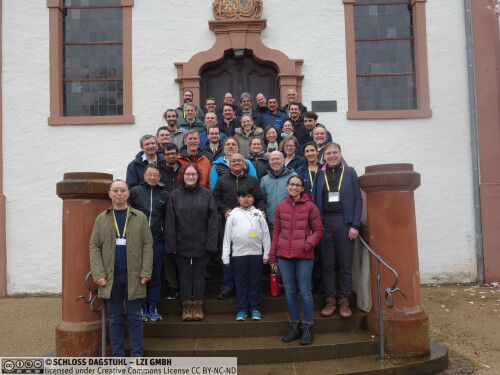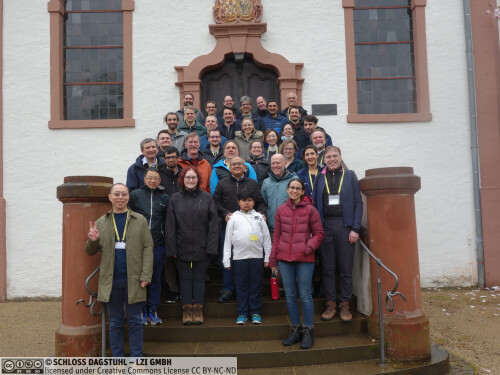Dagstuhl Seminar 24141
Network Calculus
( Apr 01 – Apr 04, 2024 )
Permalink
Organizers
- Steffen Bondorf (Ruhr-Universität Bochum, DE)
- Anne Bouillard (Huawei Technologies - Boulogne-Billancourt, FR)
- Markus Fidler (Leibniz Universität Hannover, DE)
- Jörg Liebeherr (University of Toronto, CA)
Contact
- Michael Gerke (for scientific matters)
- Christina Schwarz (for administrative matters)
Schedule
- Dagstuhl Seminar: Network Calculus - Leibniz Universität Hannover, Institut für Kommunikationstechnik: Aktuelles, February 28, 2024
Our Dagstuhl Seminar brought together leading experts in the field of network calculus to discuss recent research activities, identify future directions, and establish or strengthen cooperation. The seminar fostered collaborations and new ideas by focusing on diversity, incorporating perspectives from research and industry, varying levels and areas of expertise, and participants of different positions and ages. Attendees came from various scientific disciplines, including deterministic and stochastic network calculus, Age-of-Information, industrial communication, and wireless technologies. All combined under the need for Quality of Service (QoS) requirements. Participants contributed scientific presentations and workshops on their current and future research.
Network calculus is a theoretical framework for analyzing networks, mainly, but not limited to communication networks, but applications are also possible in the field of energy systems or even emergency call centers. By modeling data flows and systems as mathematical functions, network calculus allows the calculation of guaranteed (deterministic/stochastic) upper bounds. This analysis can be applied to various elements, including individual hops or entire systems. Additionally, network calculus has been used for certification purposes in avionic networks, such as the Airbus A380 [1], demonstrating its importance and applicability in designing safety-critical systems that require stringent QoS performance guarantees.
The seminar focused on several main areas: integrating algebras and performance metrics, exploring network topology and parallel systems, applying network calculus to emerging technologies, and developing algorithms and tools. New insights in these topics were presented, followed by group work on individual problems. These group sessions explored algorithmic challenges, mathematical and computational complications, and practical applications of network calculus.
In the context of algebras and performance metrics, discussions centered on representing network calculus as a systems theory under min-plus algebra, as well as integrating min-plus and max-plus algebras. This dual approach could provide a more comprehensive framework for analyzing complex network behaviors. A significant challenge addressed was the issue of rare perturbations, where deterministic network calculus currently lacks the ability to quantify the frequency or rarity of worst-case scenarios. Participants discussed the need for more nuanced metrics to distinguish between frequent low delays and rare high delays.
The seminar also highlighted the powerful modeling capabilities of network calculus in representing various systems, such as links, traffic shapers, and scheduling policies, which can be composed into arbitrary topologies. Advanced results from deterministic network calculus, like pay bursts and multiplexing only once phenomena, have recently been incorporated into stochastic network calculus, necessitating strong cooperation between the deterministic and stochastic communities. Parallel systems, particularly in the context of multi-path transport and fork-join models, were another central point, with discussions addressing the complexities and opportunities inherent in these configurations.
Emerging technologies such as Time-Sensitive Networking (TSN), Deterministic Networking (DetNet), and Ultra-Reliable Low Latency Communications (URLLC) were also a significant focus of the seminar. Network calculus currently receives a lot of research attention due to these emerging topics, which attract high interest from both industry and academia. These technologies are crucial for applications in factory automation, aerospace onboard systems, and automotive in-vehicle networks, where performance guarantees are critical. The seminar emphasized the integration of network calculus with these emerging technologies to ensure robust performance analysis and guarantees, supporting applications that meet stringent reliability and latency requirements.
Recent advancements in network calculus algorithms were another key theme of the seminar. Participants discussed combining modular and optimization approaches and developing highly parallelizable methods that iteratively improve performance bounds. The use of machine learning for appropriate decomposition in modular approaches was highlighted, allowing for more efficient and scalable solutions to complex network performance challenges. Additionally, the development of tools to rapidly disseminate novel results and facilitate extensive community-based research artifact evaluation and reproducibility verification was emphasized.
Discussions following each presentation helped identify open problems and challenges to be addressed by the community. Participants highlighted the importance of collaboration between the different network calculus communities and experts, the topics which are still open and where our community could focus in the future, and potentials to make network calculus more accessible to the public.
The seminar also included connecting personal and scientific discussions during a slightly rainy but enjoyable hike, long extended dinners, and quizzes to engage in team building. These social events provided additional opportunities for participants to engage and exchange ideas.
In summary, the Dagstuhl Seminar on network calculus facilitated significant discussions on advancing the field through interdisciplinary collaboration, integrating new technologies, and leveraging new methodologies for optimization. The insights and outcomes from the seminar pave the way for future research and development, ensuring network calculus receives recognition and remains a robust and versatile tool for network analysis and performance guarantees.
References
- F. Francés, C. Fraboul, and J. Grieu, Using Network Calculus to optimize the AFDX network, ERTS 2006: 3rd European Congress ERTS Embedded real-time software, 2006.
 Lisa Maile
Lisa Maile
Network calculus has become a mature and versatile methodology for the analysis of queueing systems with a broad variety of applications ranging from Internet Quality of Service (QoS), wireless networks, to Ethernet with delay guarantees, real-time systems, and feedback control. This is achieved through complementary, problem-specific representations in min-plus or max-plus algebra and the use of worst-case or statistical bounds. The goal of this Dagstuhl Seminar is to gather the deterministic and stochastic Network Calculus community, to discuss recent research activities, to identify future directions, and to strengthen cooperation. The challenges to be discussed arise in these areas:
Algebras, performance metrics and bounds: Network Calculus has a fundamental representation as a systems theory under the min-plus algebra. Related are theories, e.g., for discrete-event systems, that use a max-plus algebra, and there is also a branch of the Network Calculus that uses max-plus. An important application is recent age-of-information research. A further, methodological connection with the min-plus/max-plus systems theory of the Network Calculus may be developed in the field of feedback control of max-plus linear systems. We expect that input from the control and discrete event community to the seminar will give fresh momentum and may motivate novel joint research.
Network topology and parallel systems: A remarkable quality of the Network Calculus is its modeling power: a wide variety of systems, such as links, traffic shapers, and scheduling policies can be modeled and composed into arbitrary topologies. Some advanced results from the deterministic Network Calculus, namely the pay bursts/multiplexing only once phenomena, have only recently been incorporated into the stochastic Network Calculus. Continuing this effort requires a strong cooperation between both communities, given their complementary expertise. Another important aspect to be advanced together are parallel systems, as found in multi-path transport and in fork-join models.
TSN, DetNet, URLLC: Since recently, there has been a surge of interest in technologies for reliable and low-latency communications. Prominent examples are IEEE Time Sensitive Networking (TSN), IETF Deterministic Networking (DetNet), and 5G Ultra-Reliable Low Latency Communications (URLLC). These technologies are closely intertwined with the Network Calculus with essential applications in, e.g., factory automation, aerospace onboard, and automotive in-vehicle networks.
Algorithms and tools: Recent developments in Network Calculus algorithms can be classified as a) combining modular and optimization approaches; and b) highly parallelizable methods that iteratively improve the performance bounds. The former trend requires finding an appropriate decomposition, which can, for example, be resolved with machine learning techniques. Integrating these streams and their tool development opens up the opportunity for rapid dissemination of novel results, extensive community-based research artifact evaluation and reproducibility verification.
Design automation and configuration synthesis: Rather than aiming for a performance analysis of a fully configured system, constructive methods seek to design and configure a system that meets given performance requirements. Adapting Network Calculus for design automation and configuration is a fundamental challenge. How Network Calculus modeling and analysis can allow for such an adapted procedure with open parameters is not yet investigated in sufficient detail. Among the tools that could be used for solving such problems are, again, optimization and machine learning.
 Steffen Bondorf, Anne Bouillard, Markus Fidler, and Jörg Liebeherr
Steffen Bondorf, Anne Bouillard, Markus Fidler, and Jörg Liebeherr
- Michael Beck (University of Winnipeg, CA) [dblp]
- Steffen Bondorf (Ruhr-Universität Bochum, DE) [dblp]
- Anne Bouillard (Huawei Technologies - Boulogne-Billancourt, FR) [dblp]
- Marc Boyer (ONERA - Toulouse, FR) [dblp]
- Peter Buchholz (TU Dortmund, DE) [dblp]
- Almut Burchard (University of Toronto, CA) [dblp]
- Georg Carle (TU München - Garching, DE) [dblp]
- Samarjit Chakraborty (University of North Carolina at Chapel Hill, US) [dblp]
- Vlad-Cristian Constantin (RPTU - Kaiserslautern, DE) [dblp]
- Hugo Daigmorte (RealTime-at-Work - Nancy, FR) [dblp]
- Markus Fidler (Leibniz Universität Hannover, DE) [dblp]
- Anaïs Finzi (TTTech Computertechnik - Wien, AT) [dblp]
- Stéphane Gaubert (INRIA & CMAP, Ecole polytechnique - Palaiseau, FR) [dblp]
- Damien Guidolin--Pina (RealTime-at-Work - Nancy, FR)
- Anja Hamscher (RPTU - Kaiserslautern, DE)
- Max Helm (TU München - Garching, DE) [dblp]
- Kai-Steffen Jens Hielscher (Universität Erlangen-Nürnberg, DE) [dblp]
- Yuming Jiang (NTNU - Trondheim, NO) [dblp]
- Kai Lampka (NXP Semiconductors - München, DE) [dblp]
- Jean-Yves Le Boudec (Jouxtens-Mézery, CH) [dblp]
- Harvinder Lehal (University of Toronto, CA)
- Jörg Liebeherr (University of Toronto, CA) [dblp]
- Lisa Maile (Universität Erlangen-Nürnberg, DE) [dblp]
- Mahsa Noroozi (Leibniz Universität Hannover, DE) [dblp]
- Xi Peng (Huawei Technologies - Hong Kong, HK) [dblp]
- Stéphan Plassart (University Savoie Mont Blanc - Annecy, FR) [dblp]
- Amr Rizk (Universität Duisburg-Essen, DE) [dblp]
- Giovanni Stea (University of Pisa, IT) [dblp]
- Mina Tahmasbi Arashloo (University of Waterloo, CA) [dblp]
- Ludovic Thomas (CNRS - Villers-lès-Nancy, FR) [dblp]
- Brenton Walker (Leibniz Universität Hannover, DE) [dblp]
- Kui Wu (University of Victoria, CA) [dblp]
- Raffaele Zippo (University of Pisa, IT) [dblp]
Classification
- Networking and Internet Architecture
- Performance
Keywords
- Network calculus
- effective bandwidths
- queueing network
- performance evaluation
- age of information



 Creative Commons BY 4.0
Creative Commons BY 4.0
